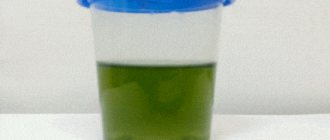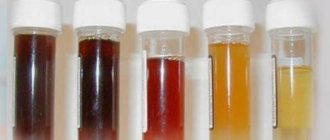Natural causes of urine color change in women
External and internal factors can affect the change in urine color.
Natural causes include the following:
| Name | Description |
| Minimum fluid level in the body | A lack of water in the body provokes dehydration. Not only does the urine become darker, but its concentration also increases. |
| Exercise stress | Intense training and high air temperatures increase the process of sweating, during which more fluid is released from the human body. Without replenishing water supplies, dehydration occurs. |
| Long-term use of certain drugs | Laxatives do more than just help with bowel movements. A large amount of fluid leaves the human body. After taking antimalarial drugs, the pigment in the urine increases, causing it to become dark. Antibacterial medications cause brown urine. The same applies to medications used to treat tuberculosis. |
| Food | Urine becomes dark after eating beef, liver, and beans. The same goes for black tea and strong coffee. |
| Morning hours | At night, a person sleeps, the kidneys function, and urine accumulates. During the night it accumulates in large quantities, which contributes to the appearance of a specific color. |
| Burns | This also applies to injuries and damage, while the urinary system operates normally. Residues from tissue breakdown enter the bloodstream and are excreted from the human body through urine. Therefore, with various injuries, injuries and burns, the urine turns brown. |
Various strict diets for weight loss are a provoking factor, against the background of which women’s urine changes its color. In old age, metabolic processes slow down. Organic substances are not completely broken down and enter the urine, causing a change in its color.
Bright orange urine due to dehydration
The loss of large amounts of fluid can be caused by:
- intense sports activities;
- lack of drink in the heat.
A person loses moisture through the skin, which means the volume of urine produced decreases. At the same time, the amount of residual metabolic products and salts remains unchanged. A decrease in the volume of fluid excreted by the kidneys leads to an increase in the concentration of particles excreted from the body in the urine.
Dehydration is a dangerous condition. If you do not replenish lost moisture, this will lead to metabolic disorders and kidney problems.
Pathological causes in women
Brown urine in women (a therapist or urologist will help determine the reasons) may be the result of the development of a serious pathological process in the body. It is necessary to undergo a full medical examination, after which the doctor will make an accurate diagnosis and select the most effective treatment.
Brown urine is caused by the following pathological conditions:
| Name | Description |
| Disorders during pregnancy | The dark color of urine in pregnant women is explained by severe toxicosis. A woman in the first trimester feels nauseous and vomits. Against the background of toxicosis, dehydration of the body is observed, which is typical for the reasons why urine turns dark. The kidneys produce less urine and its concentration increases. Sometimes a specific smell appears. During the period of bearing a baby, the load on the entire body increases, and the liver also suffers. High bilirubin levels cause colored urine. |
| Disturbances during menopause | During menopause, not only the reproductive function of the female body is disrupted, many internal organs and systems suffer. Metabolism slows down, immunity decreases. The changes also affect the functioning of the urinary system. Most women during menopause experience cystitis, which causes dark brown urine. |
| Food, medicines | Many foods contain pigments that affect the color of urine. We are talking about strong tea, legumes, beef. After drinking alcohol, urine may remain dark for a long time. Among the medications, darkening of urine is provoked by antibacterial drugs, laxatives with senna and cascura, and activated carbon. The same applies to antimalarial drugs and medications that contain aloe. |
| Liver diseases, gallbladder pathologies | High levels of bilirubin and other bile pigments turn urine brown. In diseases of the liver and gall bladder, these elements enter the blood in large quantities. In a normal state, they are excreted from the body along with feces. Darkening of urine occurs against the background of hepatitis, cholelithiasis, as a result of the formation of a malignant tumor. |
| Dehydration | Brown urine provokes fluid deficiency in the human body. The concentration of urochrome increases, causing the color of the urine to change. |
| Hemolytic anemia | Not only does a woman's urine color change. The pathological condition is characterized by a gradual decrease in the vital activity of red blood cells. They quickly age and break down. |
| Inflammation of the genitourinary system | In the female body, the reproductive system is located next to the urinary system, so the risk of developing an inflammatory process increases in case of any disorders. Flakes and mucus appear in the urine, and it darkens. Characteristic signs indicate damage to the uterus and ovaries. |
| Groin and abdominal injuries | Dark brown urine appears after injuries in the abdominal cavity. The phenomenon is called hematuria (blood in the urine). The kidneys, urinary canals and genitals are affected by injuries in the groin and abdomen. Accompanying signs in most cases are hematomas on the body, wounds and severe pain. In some situations, serious injuries trigger an inflammatory process at the site of injury, causing body temperature to rise. |
| Other reasons | Nephritis is characterized by the discharge of dark urine in women. The same applies to infectious diseases caused by streptococci. As a result of hypothermia, an inflammatory process develops that disrupts the functioning of the urinary system. |
With cirrhosis of the liver, characteristic symptoms appear, including brown urine. High levels of bilirubin lead to the formation of a specific yellow foam in the urine and spectral stains.
What does the type of brown urine mean?
The color of urine in women may vary depending on the provoking cause, from a light shade to a dark brown pigment.
| Name | Description |
| Light brown urine | A symptom of a progressive infectious disease in the genitourinary system. Associated symptoms appear:
When the liver is damaged, not only urine and feces turn yellow, but also the skin. |
| Cloudy brown urine | Causes of cloudy brown urine:
|
| Dark brown urine | The main sign of pathological processes that develop in the area of the liver and gallbladder. Bile pigments (biliverdin, bilirubin) enter the urine. Dark brown urine is accompanied by cholestasis due to cholelithiasis. |
| Brown flakes in urine | A pathological condition that indicates the development of an inflammatory process in the kidneys (cystitis, pyelonephritis, renal failure, urolithiasis). The same applies to gynecological diseases, hyperplasia, and increased protein levels. |
| Brownish mucus in urine | A painful condition when the infection penetrates the organs of the genitourinary system. The probable cause of the pathology is stagnant processes in the urinary system. |
Elevated levels of salts and urates indicate damage to the urinary system when the urine darkens. Medical diagnosis is necessary to make an accurate diagnosis.
List of diseases
A change in the color of urine may indicate pathological processes occurring in the body. These include:
- liver damage - hepatitis and cirrhosis;
- diseases of the gallbladder and bile ducts – cholelithiasis, cholestasis;
- tumor processes in the liver, pancreas, kidneys, etc.;
- hemolytic anemia;
- kidney diseases - nephrolithiasis, glomerulonephritis, polycystic disease;
- urinary tract infections;
- intoxication with copper salts;
- metabolic disorders – porphyria, tyrosinemia, hemochromatosis;
- dehydration.
It is wise to consult your doctor about any changes in your urine unless they are related to diet and/or medications.
Additional symptoms
Brown urine in women (a full medical examination, which will be prescribed by a doctor based on the patient’s complaints, will help determine the cause) in most cases is accompanied by accompanying symptoms, for which it is important to consult a general practitioner in a timely manner.
Symptoms:
- the urge to urinate becomes more frequent due to cystitis and genitourinary infections;
- emptying the bladder is accompanied by pain and pain;
- a strong smell of ammonia appears in the urine due to disorders in the kidneys and urinary ducts;
- a woman is worried about nausea and vomiting due to dysfunction of the digestive system and gall bladder;
- the skin, sclera and mucous membranes turn yellow;
- there is increased fatigue, dizziness, weakness, indicating poisoning, metabolic disorders, bleeding or damage to internal organs;
- body temperature rises (the body reacts to an infectious lesion, the development of an inflammatory process or the ingestion of toxic substances, worms);
- the process of sweating increases;
- pain is felt not only in the lower abdomen, but also in the kidney area, under the ribs (in most cases this is a sign of a violation of the integrity of internal organs, the development of an inflammatory process, or parasitic infection).
Symptoms indicate the development of pathological processes. It is important not to delay going to the doctor. It is necessary to undergo a full medical examination and establish an accurate diagnosis. Based on the results obtained, the doctor will select the most effective treatment.
Actions for dark urine
If the urine turns brown, vomiting, fever, pain in the peritoneum, or difficulty urinating appear, you should immediately consult a doctor for help. If the color change is due to the foods you eat, then you should stop consuming this type in order to return the normal color to your urine.
In order to avoid health problems, it is necessary to take blood and urine tests. Urine the color of dark beer is often due to hepatitis, when the amount of bile pigments in the body is increased - bilirubinuria. They are the causes of yellowing of the skin and sclera.
More on the topic: What pathologies can a change in the color of urine indicate?
Brown urine can be due to hemolytic anemia, when cell breakdown occurs in the blood. Increased breakdown of red blood cells provokes the circulation of bilirubin and jaundice. Another possible disorder is cirrhosis of the liver or kidney dysfunction, which worsens the removal of toxins from the body.
In what cases is a visit to the doctor necessary?
If physiological provoking factors are eliminated, the color of urine will be restored. With the progression of pathological processes, the symptoms will worsen, it is necessary to go to the hospital.
A woman needs emergency assistance if the following signs appear:
- increased sweating;
- intense pain in the lower back;
- disruption of the functioning of the gastrointestinal tract;
- headache;
- weakness in the body, fainting;
- skin rashes and itching;
- pain when urinating.
Brown mucus in the urine indicates an infection of the urinary system, so it is important to go to the hospital in a timely manner and undergo a full examination.
Causes of darkening of children's urine
The color of a child's urine depends directly on his diet. It is for this reason that when an unusual color appears, it is necessary to remember what the child ate the day before. If at the same time he feels nauseous, suffers from pain when urinating, and “burns” (increased body temperature), then this is a direct indication of pathologies in the body of bacterial or viral etiology.
As a rule, such symptoms in children are observed due to an infection in the genitourinary system, which is as common as colds among young people. The child's body differs from an adult in the absence of localization of inflammation.
The entire urinary tract, both lower and upper sections, is affected. If the color of a child's urine changes, you need to seek help from a pediatrician, who will prescribe additional tests and prescribe comprehensive treatment.
Diagnostics
A medical examination is necessary to make an accurate diagnosis. It is important to go to the hospital when the first signs appear, the therapist will prescribe a diagnosis and, based on the results, select a safe therapy.
If dark brown urine appears, a woman is prescribed the following examination methods:
| Name | Description |
| General blood analysis | The results will show the levels of creatine, urea, nitrogen and enzymes secreted by the liver. The test helps to assess the general condition of the human body and identify the inflammatory process. |
| General urine analysis | The study will determine the level of protein in urine and the concentration of red blood cells. |
| Radiography | A diagnostic method that allows you to identify sand or stones in the kidneys and ureter. |
| Ultrasound examination (ultrasound) | The specialist examines and assesses the condition of the abdominal organs and pelvis. |
Additionally, to obtain more information in order to make an accurate diagnosis, the patient is prescribed computed tomography and magnetic resonance imaging (CT, MRI), as well as a smear for cytology and flora.
If necessary, given the cause of dark brown urine, a woman may need to consult a urologist, andrologist, oncologist, surgeon, gastroenterologist or hepatologist.
Treatment for brown urine
Complex therapy is selected by a general practitioner or urologist, taking into account the provoking source of the disorders. The woman is prescribed medications and is also advised to adhere to a strict diet. In severe situations with severe lesions, surgical intervention is indicated.
Drug therapy
It is important to take medications strictly as prescribed by a specialist or after studying the instructions first. Many drugs cause side effects.
Incorrectly selected medications or non-compliance with the treatment regimen will lead to serious complications.
Urine that is brown in color in women (the causes must be determined at an early stage of the development of the pathological process in order to begin timely therapy), taking into account the source of the disorder, is treated with certain medications.
Such as:
| Group of drugs | Name | Application |
| Antibacterial drugs | Ceftriaxone, Ofloxacin | The daily dosage for an adult is 1-2 g. The course of treatment and regimen depend on the patient's condition. On average, therapy lasts 7-14 days. |
| Diuretics | Mannitol, Furosemide | The medicine is administered intravenously. The adult dosage is 0.5-1.5 g/kg. Before administration, the medicine is dissolved with isotonic sodium chloride solution or glucose. |
| Enzymes | Creon | The medicine is taken orally with a sufficient amount of water. The adult dosage is 1-2 capsules with the main meal. |
| Medicines for the liver | Darsil, Allohol | The drug is taken orally without chewing and washed down with water after meals. Adults are prescribed 1-4 tablets, taking into account the condition of the body, 3 times a day. The duration and regimen of therapy is selected individually. The average is 3 months. |
| Antispasmodics | No-Shpa, Trimedat | The adult dosage is 1-2 tablets 3 times a day. |
If necessary, in difficult situations, the woman undergoes detoxification therapy. Medicines are administered intravenously through a dropper (sodium chloride, glucose). Oncological pathologies require an individual treatment regimen and selection of medications. The same applies to gynecological diseases for which additional hormonal therapy is used.
Operations
In the case when drug therapy does not give positive dynamics, the pathological processes progress, the patient is indicated for surgical intervention.
Main indications for surgery:
- formation of stones in the urinary tract or gall bladder;
- the appearance of malignant tumors in the organs of the genitourinary system;
- liver cancer;
- painful sensations for which medications do not help;
- ureteral obstruction;
- renal failure;
- purulent inflammatory process in the organs of the genitourinary system;
- cyst formation.
Taking into account the reason for the appearance of brown urine in a person, the most effective surgical treatment is selected.
Diet
Brown urine in women (the reasons may be different, so it is important to determine the source through a medical examination and begin therapy) is treated with complex methods. Additionally, the fight against dark brown urine involves following a strict diet, especially at the stage of exacerbation of the provoking disease.
One of the methods for treating brown urine in women is to follow a diet.
| Recommended Products | Prohibited Products |
|
|
A woman is recommended to eat in small portions up to 6 times a day. Also observe the drinking regime, drink more liquids (teas, juices, decoctions, compotes, fruit drinks).
Brown urine should not be ignored. It is important to promptly determine the cause in a woman and carry out treatment. In some situations, physiological factors provoke a change in urine color.
A thorough medical diagnosis will help exclude pathological causes. Otherwise, if this is a disease and it progresses, serious complications will arise.
Prevention
If your urine becomes cloudy, you should drink more clean water.
In the future, follow simple rules:
- Reduce alcohol consumption.
- Avoid products that cause color change.
- Give up exhausting diets.
- Reduce physical activity, if any.
- Pay attention to medications and vitamin complexes that you are taking or have recently taken.
- Try not to overcool the body or expose it to severe overheating.
- Eliminate spicy, smoked, and canned foods from your diet for a while, which retain water in the body and interfere with the cleansing effect.
- Limit consumption of protein foods and salt.









